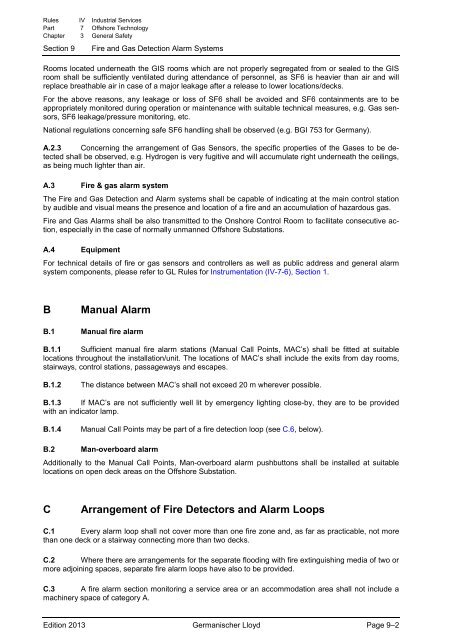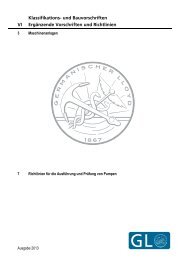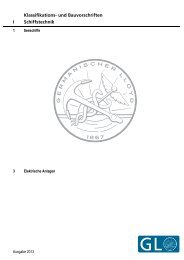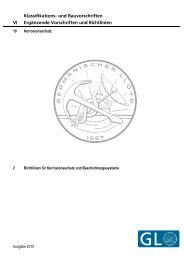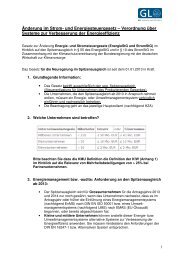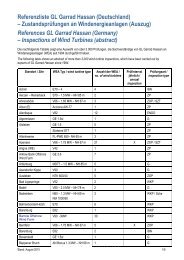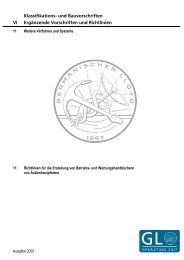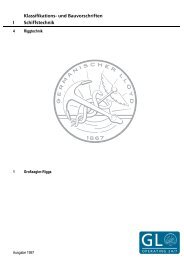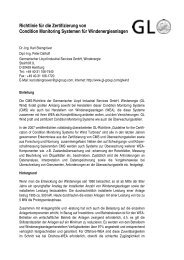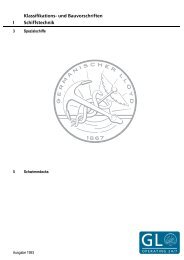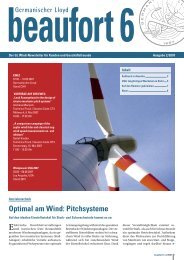(IV-7-3) General Safety
(IV-7-3) General Safety
(IV-7-3) General Safety
Create successful ePaper yourself
Turn your PDF publications into a flip-book with our unique Google optimized e-Paper software.
Rules <strong>IV</strong> Industrial Services<br />
Part 7 Offshore Technology<br />
Chapter 3 <strong>General</strong> <strong>Safety</strong><br />
Section 9<br />
Fire and Gas Detection Alarm Systems<br />
Rooms located underneath the GIS rooms which are not properly segregated from or sealed to the GIS<br />
room shall be sufficiently ventilated during attendance of personnel, as SF6 is heavier than air and will<br />
replace breathable air in case of a major leakage after a release to lower locations/decks.<br />
For the above reasons, any leakage or loss of SF6 shall be avoided and SF6 containments are to be<br />
appropriately monitored during operation or maintenance with suitable technical measures, e.g. Gas sensors,<br />
SF6 leakage/pressure monitoring, etc.<br />
National regulations concerning safe SF6 handling shall be observed (e.g. BGI 753 for Germany).<br />
A.2.3 Concerning the arrangement of Gas Sensors, the specific properties of the Gases to be detected<br />
shall be observed, e.g. Hydrogen is very fugitive and will accumulate right underneath the ceilings,<br />
as being much lighter than air.<br />
A.3 Fire & gas alarm system<br />
The Fire and Gas Detection and Alarm systems shall be capable of indicating at the main control station<br />
by audible and visual means the presence and location of a fire and an accumulation of hazardous gas.<br />
Fire and Gas Alarms shall be also transmitted to the Onshore Control Room to facilitate consecutive action,<br />
especially in the case of normally unmanned Offshore Substations.<br />
A.4 Equipment<br />
For technical details of fire or gas sensors and controllers as well as public address and general alarm<br />
system components, please refer to GL Rules for Instrumentation (<strong>IV</strong>-7-6), Section 1.<br />
B<br />
Manual Alarm<br />
B.1 Manual fire alarm<br />
B.1.1 Sufficient manual fire alarm stations (Manual Call Points, MAC’s) shall be fitted at suitable<br />
locations throughout the installation/unit. The locations of MAC’s shall include the exits from day rooms,<br />
stairways, control stations, passageways and escapes.<br />
B.1.2<br />
The distance between MAC’s shall not exceed 20 m wherever possible.<br />
B.1.3 If MAC’s are not sufficiently well lit by emergency lighting close-by, they are to be provided<br />
with an indicator lamp.<br />
B.1.4<br />
Manual Call Points may be part of a fire detection loop (see C.6, below).<br />
B.2 Man-overboard alarm<br />
Additionally to the Manual Call Points, Man-overboard alarm pushbuttons shall be installed at suitable<br />
locations on open deck areas on the Offshore Substation.<br />
C<br />
Arrangement of Fire Detectors and Alarm Loops<br />
C.1 Every alarm loop shall not cover more than one fire zone and, as far as practicable, not more<br />
than one deck or a stairway connecting more than two decks.<br />
C.2 Where there are arrangements for the separate flooding with fire extinguishing media of two or<br />
more adjoining spaces, separate fire alarm loops have also to be provided.<br />
C.3 A fire alarm section monitoring a service area or an accommodation area shall not include a<br />
machinery space of category A.<br />
Edition 2013 Germanischer Lloyd Page 9–2


